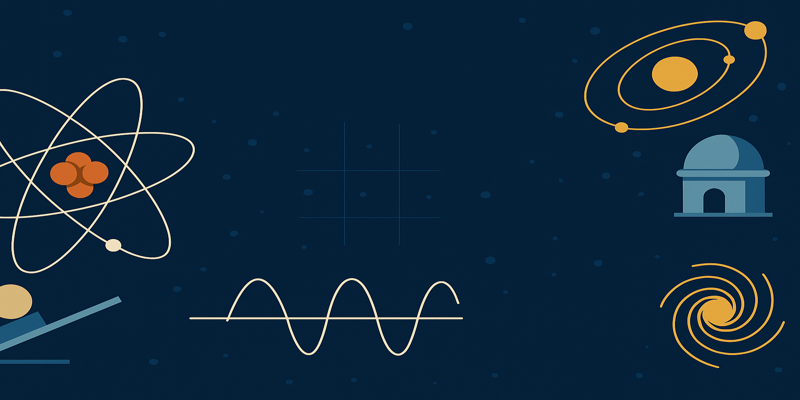Physics: An Overview of Key Study Modules Within the Field
Physics is often regarded as the most fundamental of all sciences. It explores the basic principles governing the universe — from the smallest subatomic particles to the vastness of intergalactic space. While its history is rooted in natural philosophy, modern physics encompasses an incredibly broad spectrum of specialised modules. This article provides an accessible yet structured overview of key study areas within physics, drawing on respected textbooks, academic journals, and educational resources, with references following the Harvard system. 1.0 Classical Mechanics: The Foundation of Physical Motion Classical mechanics is the study of motion and forces on macroscopic objects. Developed through the pioneering work of Isaac Newton, this module forms the basis for understanding how and why objects move. This field encompasses kinematics, dynamics, statics, and fluid mechanics. Though modern physics has extended far beyond Newton’s laws, classical mechanics remains relevant in fields such as engineering, architecture, and planetary motion (Young & Freedman, 2019). For instance, Newton’s second law, F=maF = maF=ma, continues to underpin countless engineering applications, from car crash simulations to bridge design. 2.0 Electromagnetism: Unifying Electricity and Magnetism Electromagnetism studies the interaction between electric charges, magnetic fields, and electromagnetic waves. It is essential in understanding how electronic devices, power generation systems, and even human brainwaves function. This module revolves around the Maxwell equations, which elegantly unify electric and magnetic phenomena into a coherent theory (Griffiths, 2017). Applications include radio wave transmission, MRI imaging, and wireless communication systems. Furthermore, the discovery of electromagnetic waves paved the way for the entire field of modern telecommunications. 3.0 Thermodynamics and Statistical Mechanics Thermodynamics is the science of heat, work, and energy transfer. It defines the laws governing systems ranging from steam engines to black holes. Its four laws — especially the second law relating to entropy — govern not only engines but also biological systems, chemical reactions, and cosmological expansion. Meanwhile, statistical mechanics connects the behaviour of individual atoms to the macroscopic properties of matter (Mandl, 2013). This probabilistic approach is fundamental in explaining phenomena such as phase transitions, heat capacity, and emergent behaviour in complex systems. 4.0 Quantum Mechanics: Physics at the Microscopic Scale No module in physics is as philosophically challenging and experimentally powerful as quantum mechanics. It governs the subatomic realm, where particles behave like waves, probabilities replace certainties, and observation affects outcomes. Formally introduced by the likes of Heisenberg, Schrödinger, and Dirac, this field is responsible for technological revolutions like semiconductors, lasers, and quantum computing (Sakurai & Napolitano, 2020). Quantum theory has also challenged long-held intuitions about causality, locality, and determinism — sparking philosophical debates that continue to this day. 5.0 Relativity: Space, Time, and Gravity Redefined Albert Einstein’s theories of special and general relativity revolutionised our understanding of space, time, and gravity. Special relativity introduced the idea that the speed of light is a universal constant and that time and space are relative to an observer’s motion. General relativity extended this by showing that mass bends space-time, leading to predictions of black holes, gravitational waves, and cosmic expansion (Carroll, 2019). Recent discoveries such as the detection of gravitational waves by LIGO in 2015 provide stunning confirmations of Einstein’s century-old theories (Abbott et al., 2016). 6.0 Nuclear and Particle Physics This module delves into the heart of the atomic nucleus and the fundamental particles that comprise all matter. It explores forces such as the strong nuclear force, which binds protons and neutrons, and the weak force, responsible for radioactive decay. The development of the Standard Model of particle physics — detailing interactions between quarks, leptons, and bosons — is one of modern physics’ crowning achievements (Halzen & Martin, 2008). Experiments at facilities like CERN’s Large Hadron Collider continue to search for physics beyond the Standard Model, including dark matter, supersymmetry, and extra dimensions. 7.0 Condensed Matter Physics The physics of solids and liquids, known as condensed matter physics, is one of the most experimentally diverse modules. It includes the study of crystals, superconductors, magnetic materials, and semiconductors. One of the most intriguing phenomena in this area is high-temperature superconductivity, which defies full explanation even after decades of research (Kittel, 2005). Moreover, condensed matter theory has laid the groundwork for quantum technologies and the information age. 8.0 Astrophysics and Cosmology These modules apply physics to the study of the universe, from the life cycle of stars to the Big Bang and the structure of galaxies. Astrophysics relies heavily on data from telescopes and satellites, interpreting light across the electromagnetic spectrum. Topics include stellar evolution, planetary systems, exoplanets, and cosmic microwave background radiation (Ryden, 2016). Cosmology, a closely related subfield, tackles profound questions about the origin, fate, and geometry of the universe. 9.0 Mathematical Methods in Physics Every branch of physics relies on robust mathematical tools. Modules in this area cover differential equations, Fourier analysis, linear algebra, and tensor calculus, often tailored for physical applications. These tools allow physicists to model phenomena ranging from vibrations in strings to quantum field fluctuations (Boas, 2006). Understanding these methods is crucial for transitioning from conceptual physics to quantitative problem-solving, simulations, and theoretical modelling. 10.0 Modern Frontiers and Interdisciplinary Physics Modern physics is increasingly interdisciplinary. Fields such as biophysics, medical physics, quantum information, and environmental physics are rapidly expanding. For example, quantum biology investigates whether phenomena like photosynthesis or avian navigation exploit quantum coherence (Lambert et al., 2013). Similarly, medical physics applies ionising radiation and imaging techniques in diagnostics and cancer treatment, making physics vital to public health. Physics is not just a subject — it is a dynamic and evolving tapestry of knowledge that underpins our understanding of the universe. Each module discussed here — from classical mechanics to quantum theory — builds upon the last, forming an intricate web of principles, laws, and models that describe nature with astonishing precision. The beauty of physics lies not only in its capacity to explain but also in its power to inspire curiosity and innovation. As we continue exploring the physical world, the boundaries of these modules will expand, intersect, and give rise to … Read more










